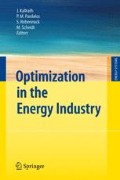Summary
Recent changes in electric network infrastructure and government policies have created opportunities for the employment of distributed generation to achieve a variety of benefits. In this paper we propose a decisions support system to assess some of the technical benefits, namely: (1) voltage profile improvement; (2) power losses reduction; and (3) network capacity investment deferral, brought through branches congestion reduction. The simulation platform incorporates the classical Newton—Raphson algorithm to solve the power flow equations. Simulation results are given for a real Semiurban medium voltage network, considering different load scenarios (Summer, Winter, Valley, Peak and In Between Hours), different levels of microgeneration penetration, and different location distributions for the microgeneration units.
Access this chapter
Tax calculation will be finalised at checkout
Purchases are for personal use only
Preview
Unable to display preview. Download preview PDF.
References
A. R. Abdelaziz and W. M. Ali. Dispersed generation planning using a new evolutionary approach. In IEEE Power Tech Conference Proceedings, 2003 IEEE Bologna, volume 2, page 5, 2003
P. P. Barker. Determining the impact of distributed generation on power systems: Part i-radial distributed systems. In IEEE Power Engineering Society Summer Meeting, volume 3, pages 1645–1656, 2000
R. E. Brown and L. A. A. Freeman. Analyzing the reliability impact on distributed generation. In IEEE Power Engineering Society Summer Meeting, volume 2, pages 1013–1018, 2001
R. E. Brown, X. Feng, J. Pan, and K. Koutlev. Siting distributed generation to defer t&d expansion. In Transmission and Distribution Conference and Expo, volume 2, pages 622–627, 2001
P. Chiradeja and R. Ramakumar. A probabilistic approach to the analysis of voltage profile improvement with distributed wind electric generation. In IEEE Frontiers of Power Conference, pages XII 1–XII 10, 2001
P. Chiradeja and R. Ramakumar. Voltage profile improvement with distributed wind turbine generation— a case study. In IEEE Power Engineering Society General Meeting, volume 4, page 236, 2003
P. Chiradeja and R. Ramakumar. An approach to quantify the technical benefits of distributed generation. IEEE Transactions On Energy Conversion, 19(4):764–773, 2004
L. Dale. Distributed generation transmission. In IEEE Power Engineering Society Winter Meeting, volume 1, pages 132–134, 2002
J. Dolezal, P. Santarius, J. Tlusty, V. Valouch, and F. Vybiralik. The effect of dispersed generation on power quality in distribution system. In Quality and Security of Electric Power Delivery Systems, 2003. CIGRE/PES 2003. CI-GRE/IEEE PES International Symposium, pages 204–207, 2003
M. Gandomkar, M. Vakilian, and M. Ehsan. Optimal distributed generation allocation in distribution network using hereford ranch algorithm. In IEEE Electrical Machines and Systems, 2005. ICEMS 2005. Proceedings of the Eighth International Conference on, volume 2, pages 916–918, 2005
H. A. Gil and G. Jöos. On the quantification of the network capacity deferral value of distributed generation. IEEE Transactions on Power Systems, 21:1592– 1599, 2006
J. J. Grainger and W. D. Stevenson. Power Systems Analysis. McGraw-Hill, New York, 1994
N. Hadjsaid, J. F. Canard, and F. Dumas. Dispersed generation impact on distribution networks. IEEE Computer Applications in Power, 12:22–28, 1999
T. Hoff and D. S. Shugar. The value of grid-support photovoltaics in reducing distribution system losses. IEEE Transactions on Energy Conversion, 10:569– 576, 1995
G. Jos, B. T. Ooi, D. McGillis, F. D. Galiana, and R. Marceau. The potential of distributed generation to provide ancillary services. In IEEE Power Engineering Society Summer Meeting, 2000
J. A. P. Lopes. Integration of dispersed generation on distribution networks-impact studies. In IEEE Power Engineering Society Winter Meeting, volume 1, pages 323–328, 2002
M. R. Milligan and M. S. Graham. An enumerated probabilistic simulation technique and case study: Integrating wind power into utility production cost models. In National Renewable Energy Lab. for Wind Energy Program, 1996
J. Oyarzabal, N. Hatziargyriou, J. Peas Lopes, A. Madureira, C. Moreira, and Aris Androutsos. Di3—report on socio-economic evaluation of microgrids. Project Consortium European Commission, 2005
Parliament and Council of the European Union. Directive /77/ec of the european parliament and of the council of 27 september 2001 on the promotion of electricity produced from renewable energy sources in the internal electricity market. Official Journal of the European Communities, 44:33–40, 2001
S. Rahman. Fuel cell as a distributed generation technology. In IEEE Power Engineering Society Summer Meeting, volume 1, pages 551–552, 2001
H. Saadat. Power Systems Analysis. McGraw-Hill, New York, 2nd edition, 2002
S. Silva. Anlise do impacto da pequena gerao dispersa sob diferentes directivas de regulao. Dissertation, Faculdade de Economia da Universidade do Porto, 2007
T. Tran-Quoc, C. Andrieu, and N. Hadjsaid. Technical impacts of small distributed generation units on lv networks. In IEEE Power Engineering Society General Meeting, volume 4, page 2464, 2003
H. L. Willis and W. G. Scott. Distributed power generation. Planning and evaluation. Marcel Dekker, New York, 2000
Author information
Authors and Affiliations
Editor information
Editors and Affiliations
Rights and permissions
Copyright information
© 2009 Springer-Verlag Berlin Heidelberg
About this chapter
Cite this chapter
Fidalgo, J.N., Fontes, D.B.M.M., Silva, S. (2009). A Decision Support System to Analyze the Influence of Distributed Generation in Energy Distribution Networks. In: Kallrath, J., Pardalos, P.M., Rebennack, S., Scheidt, M. (eds) Optimization in the Energy Industry. Energy Systems. Springer, Berlin, Heidelberg. https://doi.org/10.1007/978-3-540-88965-6_4
Download citation
DOI: https://doi.org/10.1007/978-3-540-88965-6_4
Publisher Name: Springer, Berlin, Heidelberg
Print ISBN: 978-3-540-88964-9
Online ISBN: 978-3-540-88965-6
eBook Packages: EngineeringEngineering (R0)

